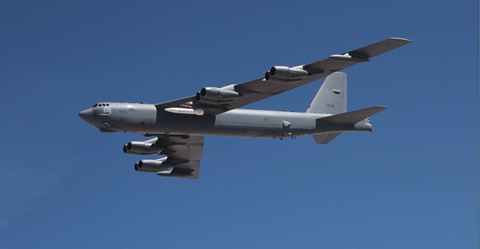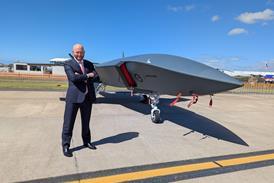The US Air Force (USAF) demonstrated a Boeing B-52 Stratofortress bomber carrying out a simulated hypersonic missile strike using targeting data from sensors positioned more than 1,000nm (1,850km) away.
The simulation took place on 5 May during the Northern Edge 21 exercises in Alaska, the service said on 10 May. The joint training exercises include participation from members of the USAF, US Army, US Navy and US Marine Corps.

As part of the All-Domain Operations Capability experiment, a B-52 took off from Barksdale AFB in Louisiana and flew north, toward Alaska. En route, the bomber received targeting data from sensors that were positioned more than 1,000nm away at Joint Base Elmendorf-Richardson in southern Alaska. The type of sensors was not disclosed.
“The bomber then was able to successfully take a simulated shot of the target from 600nm away using an AGM-183 Air Launched Rapid Response Weapon (ARRW)”, says the USAF. “This was a successful showcase of beyond-line of sight kill chain employment, and notably, was a success in the highly contested and realistic threat environment that Northern Edge provides”.
The Lockheed Martin-made ARRW is a boost-glide hypersonic missile that is in testing. The weapon has not flown yet. In April, the first free-flight rocket booster test of the missile failed after something went wrong during its launch sequence. The USAF anticipates further tests of ARRW through 2022 and wants the missile to be its first operational hypersonic weapon.
Demonstrating the ability to spot and target an adversary at distant ranges is important to make use of hypersonic missiles’ long ranges. The ARRW reportedly has a range of 869nm.
The exercise also is practice for the USAF’s effort to connect its various aircraft and sensors as part of a future Advanced Battle Management System, a future battlefield network.
“We were really exercising the data links that we needed in order to complete that kill chain loop, and then get the feedback to the players in the airspace that the simulated hypersonic missile was fired and effective,” says Lieutenant Colonel Joe Little, deputy commander of the 53rd Test Management Group.
After the simulated missile launch, the B-52 turned back and landed at Barksdale about 13h later. As part of a relatively new strategy, called Dynamic Force Employment, the USAF is basing its bombers within the USA and calling upon the aircraft to make unpredictable long-range flights anywhere in the world on short notice. The service believes the unpredictability of the strategy will keep adversaries like China and Russia on their toes.































